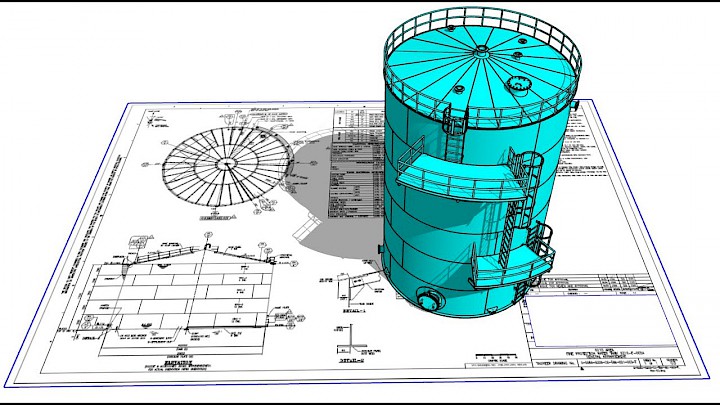Systematic Overview of API 650 Welding Inspection Approaches and Instruments
How Welding Evaluation Works: A Comprehensive Overview for Professionals
Welding examination plays an essential role in making sure the security and integrity of welded structures. It involves a systematic approach that consists of both visual assessment and advanced screening techniques. Experts should familiarize themselves with key criteria and laws controling the sector. Understanding the usual flaws that can occur throughout welding is essential. This overview will discover these components in information, providing insights right into the processes that support high quality and integrity in welding.
Comprehending the Significance of Welding Inspection
While several may underestimate the value of welding evaluation, it plays a vital role in making sure the stability and safety of welded frameworks. Effective welding examination identifies prospective defects and imperfections that can compromise structural toughness and bring about disastrous failures. The inspection procedure includes numerous techniques, such as aesthetic examinations, ultrasonic screening, and radiographic analyses, each adding to the total assessment of weld top quality.
Along with securing the architectural integrity, welding evaluation ensures compliance with industry standards and customer specs. By making sure that welds fulfill required attributes and resistances, examinations aid maintain the reliability and longevity of components in different applications, from building and construction to aerospace. A rigorous evaluation procedure promotes a culture of quality and accountability amongst suppliers and welders. Eventually, welding evaluation is not simply a procedural step; it is a crucial practice that underpins the safety and security and efficiency of engineered systems across diverse fields.
Trick Requirements and Laws in Welding Inspection
The foundation of reliable welding evaluation relaxes on adherence to established criteria and policies. Different companies, such as the American Welding Culture (AWS) and the American National Specification Institute (ANSI), set forth standards that assure high quality and safety and security in welding techniques. Secret standards, such as AWS D1.1 for architectural welding and ASME Section IX for pressure vessels, supply detailed requirements for welding evaluations, procedures, and credentials. Regulatory frameworks, consisting of those from the Occupational Safety and Health And Wellness Management (OSHA), mandate security methods and worker defenses in welding environments. Compliance with these requirements is essential for achieving consistent weld quality and lessening the danger of failures. Furthermore, worldwide requirements like ISO 3834 additionally boost international uniformity in welding examination practices. Professionals should stay notified concerning these laws to guarantee that their evaluation techniques line up with market expectations and legal requirements, thus protecting both personnel and structural integrity.
First Prep Work and Aesthetic Examination Techniques

Effective welding evaluation starts with a detailed pre-inspection checklist that ensures all necessary problems are met before the real assessment takes area. Following this prep work, visual issue identification plays an essential function in reviewing weld quality, enabling assessors to detect problems such as cracks or improper combination. With each other, these techniques develop the foundation for an effective welding inspection process.
Pre-Inspection Checklist
Prior to starting any kind of welding examination, a complete pre-inspection list is vital to assure that all required preparations are completed and that visual inspection strategies are properly employed. Crucial element of this list consist of confirming the welding treatment requirements (WPS), making certain all equipment is calibrated and in great functioning condition, and verifying that the assessor has the called for qualifications. Additionally, it is important to examine any type of previous examination records and to analyze the job setting for safety and security threats. The assessor should also verify that all pertinent documentation, such as product certificates and examination records, is conveniently offered. Finishing this checklist helps to establish a solid structure for an effective evaluation process, enhancing the integrity of the outcomes obtained.
Aesthetic Flaw Identification
A successful visual flaw identification process begins with mindful initial preparation and the application of well-known visual assessment techniques. Assessors ought to guarantee that the welding location is well-lit and clean, as appropriate visibility is crucial for discovering issues. A comprehensive exam of the weld joint's surface area enables the recognition of discontinuities, such as splits, damages, or porosity. Inspectors typically use devices like magnifying glasses or mirrors to enhance their sight of hard-to-reach areas. Furthermore, they must be acquainted with the specific welding requirements and guidelines relevant to the project. By sticking to these approaches, inspectors can successfully recognize prospective issues, protecting the stability of the weld and compliance with industry requirements.
Non-Destructive Screening Techniques: A Summary
Non-destructive screening (NDT) methods play a crucial role in the welding evaluation process by guaranteeing the honesty and integrity of bonded structures without causing any damages (API 650 Welding Inspection). These methods enable examiners to evaluate the top quality of welds while maintaining the parts being analyzed. Usual NDT approaches consist of Learn More Here ultrasonic testing, radiographic screening, magnetic particle screening, and color penetrant testing, each offering one-of-a-kind benefits
Ultrasonic testing utilizes high-frequency acoustic go waves to spot inner defects, while radiographic testing utilizes X-rays or gamma rays to picture the internal structure of welds. Magnetic fragment testing exposes surface and near-surface issues by applying an electromagnetic field and iron particles to the weld location. Dye penetrant screening highlights surface-breaking flaws via the application of a colored color. With each other, these NDT techniques provide critical understandings right into weld quality, enabling specialists to make enlightened decisions relating to safety and conformity in welding applications.
Common Flaws and Their Implications
Determining typical issues in welded joints is necessary for preserving architectural honesty and safety. Different issues can arise during the welding procedure, each lugging potential implications for the overall performance of the framework. Porosity, defined by tiny gas pockets within the weld, can compromise the joint and jeopardize its load-bearing capability. Splits might develop as a result of thermal stress and anxiety or incorrect cooling, leading to potential failure under stress and anxiety. Incomplete fusion happens when the weld steel does not fully bond with the base product, resulting in weak joints that might not endure intended loads. Undercutting, where the base steel is worn down, can likewise decrease the efficient cross-section of the weld. Additionally, too much support can develop stress and anxiety focus that can lead to failing. Identifying these flaws promptly permits for restorative actions, making certain the long life and reliability of welded structures in vital applications.
Tools and Equipment Made Use Of in Welding Examination
Effective welding inspection relies upon a range of specialized tools and equipment to assure the high quality and read review stability of welded joints. Important instruments consist of visual inspection devices, such as amplifying borescopes and glasses, which allow assessors to very closely examine welds for surface flaws. Non-destructive testing (NDT) methods, such as ultrasonic testing, radiographic screening, and magnetic bit screening, are basic for determining internal problems without damaging the product.
Measurement tools, including calipers and weld determines, help ascertain and examine dimensions conformity with specifications. Furthermore, hardness testers review the mechanical buildings of welded joints. Individual protective devices (PPE) is additionally vital, securing the security of assessors while operating in potentially unsafe atmospheres (API 650 Welding Inspection). Each tool serves a certain function, jointly enhancing the effectiveness of welding evaluation and adding to the dependability of finished projects
Often Asked Inquiries
What Credentials Are Required to Become a Welding Inspector?
To end up being a welding assessor, people generally need relevant certifications, such as AWS CWI or CSWIP, together with experience in welding processes, design concepts, and understanding of evaluation methods, security requirements, and suitable codes.
How Usually Should Welding Inspections Be Conducted?
Welding inspections ought to be conducted consistently, preferably at different task stages, consisting of pre-weld, during-weld, and post-weld. Regularity might likewise depend upon industry requirements, job specs, and the complexity of the welds included.
Can Welding Defects Be Repaired After Inspection?

Yes, welding flaws can frequently be fixed after evaluation. Relying on the seriousness and kind of problem, appropriate methods such as remodeling or extra welding may be utilized to restore architectural honesty and security conformity.
What Industries Require Routine Welding Assessments?

Various markets, consisting of building and construction, manufacturing, aerospace, and vehicle, call for normal welding examinations - API 650 Welding Inspection. These assessments assure adherence to safety and security criteria and high quality control, decreasing threats connected with structural integrity and operational efficiency in bonded parts
Exactly how Do I Choose a Welding Assessment Solution?
To pick a welding examination solution, one must think about certifications, experience, qualifications, and market track record. Furthermore, examining client evaluations and guaranteeing the solution satisfies appropriate standards can aid assure high quality evaluations and dependable results.

While numerous might ignore the relevance of welding assessment, it plays a necessary duty in ensuring the stability and safety and security of welded structures. Key criteria, such as AWS D1.1 for architectural welding and ASME Section IX for pressure vessels, give complete requirements for welding examinations, credentials, and procedures. Efficient welding assessment starts with a thorough pre-inspection list that assures all essential problems are met before the actual inspection takes area. Prior to starting any type of welding assessment, a detailed pre-inspection checklist is important to guarantee that all required preparations are finished and that visual inspection strategies are properly utilized. Non-destructive testing (NDT) methods play a crucial duty in the welding inspection procedure by making certain the stability and reliability of bonded structures without creating any type of damages.